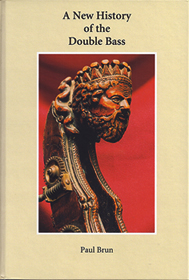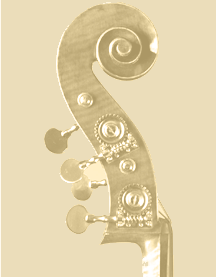Paul Brun, A New History of the Double Bass
 The
book, "A New History of the Double Bass" by Paul Brun is a
wonderfully insightful and educational reference book. It
helps take out some of the mysteries and myths surrounded with the
evolution of the upright bass and performance practices. This
is a must read for anyone that is dedicated to learning and knowing
more about the bass. It's useful for college bass music
majors, professional players and should be in every music school
reference library. The book is the next best option to an
actual Time Machine! (Order here:
Paul
Brun, A New History of the Double Bass book.) The
book, "A New History of the Double Bass" by Paul Brun is a
wonderfully insightful and educational reference book. It
helps take out some of the mysteries and myths surrounded with the
evolution of the upright bass and performance practices. This
is a must read for anyone that is dedicated to learning and knowing
more about the bass. It's useful for college bass music
majors, professional players and should be in every music school
reference library. The book is the next best option to an
actual Time Machine! (Order here:
Paul
Brun, A New History of the Double Bass book.)
While there are probably hundreds of books written about the
violin, there are only 2 or 3 really to speak of, which are
dedicated to the double bass. Mr. Brun's book encompasses many
facets of the bass' historical background.
1) It begins with all sorts of insights on how the bass was first
constructed, the size, and physical descriptions and evolutions: the
flat back bass, beveled back, violin form and carved back
construction.
2) Genesis of the Double Bass, the historical account of
how the bass (as we know it today) became more favored over the
plethora of other low pitched 'bass' instruments in the early 1600's
and on. How different countries (and regions) had their own
needs, influences and performance requirements for the bass.
3) Playing Standards. (I like this part) as kind of
a 'take us by time machine' with coverage of the different playing
'schools' and the early stages of the first music written
specifically for the bass solo. There was once a bass that was
so powerful (and hard to play) that the players had to use leather
gloves when they played!
4) The 'Golden Age' of Virtuosity, a great chapter
on when and how all the major bass concertos (Vanhal, Dittersdorf,
Hoffmeister etc..) and how the changes to the bass helped make it
more accessible as a solo instrument.
Also covered in this book an in depth historical survey of
tunings, the hows and whys we see music written in the
17th or 18th centuries with certain keys and how string numbers and
tunings varied so greatly from region to region. There are
chapters which document the various sizes of the bass. The
bow: How it evolved to what it is today, as well as regional
explanations for underhand (German style) or overhand (French) style
playing. He covers extended explanations of the parts of the
bass we often take for granted: the bridge, the endpin, frets and
strings etc... and lastly some nice biographical
backgrounds of the historically well known players (Bottesini) and
not so well known players (Antonio Dall'Occa?) that have influenced
the way the bass is played today.
This is a great book and there is no other like it.
It educates and explains how the bass began and how it slowly
evolved to what it is today. It's also a great book in that it
gives today's players a historical account of the hows and whys and
while it may seem so different today (with our 'easy' set ups and
low action metal strings...) it shows how much our roles as being
bass players, in many ways, still the same as it was 300 years ago.
|


